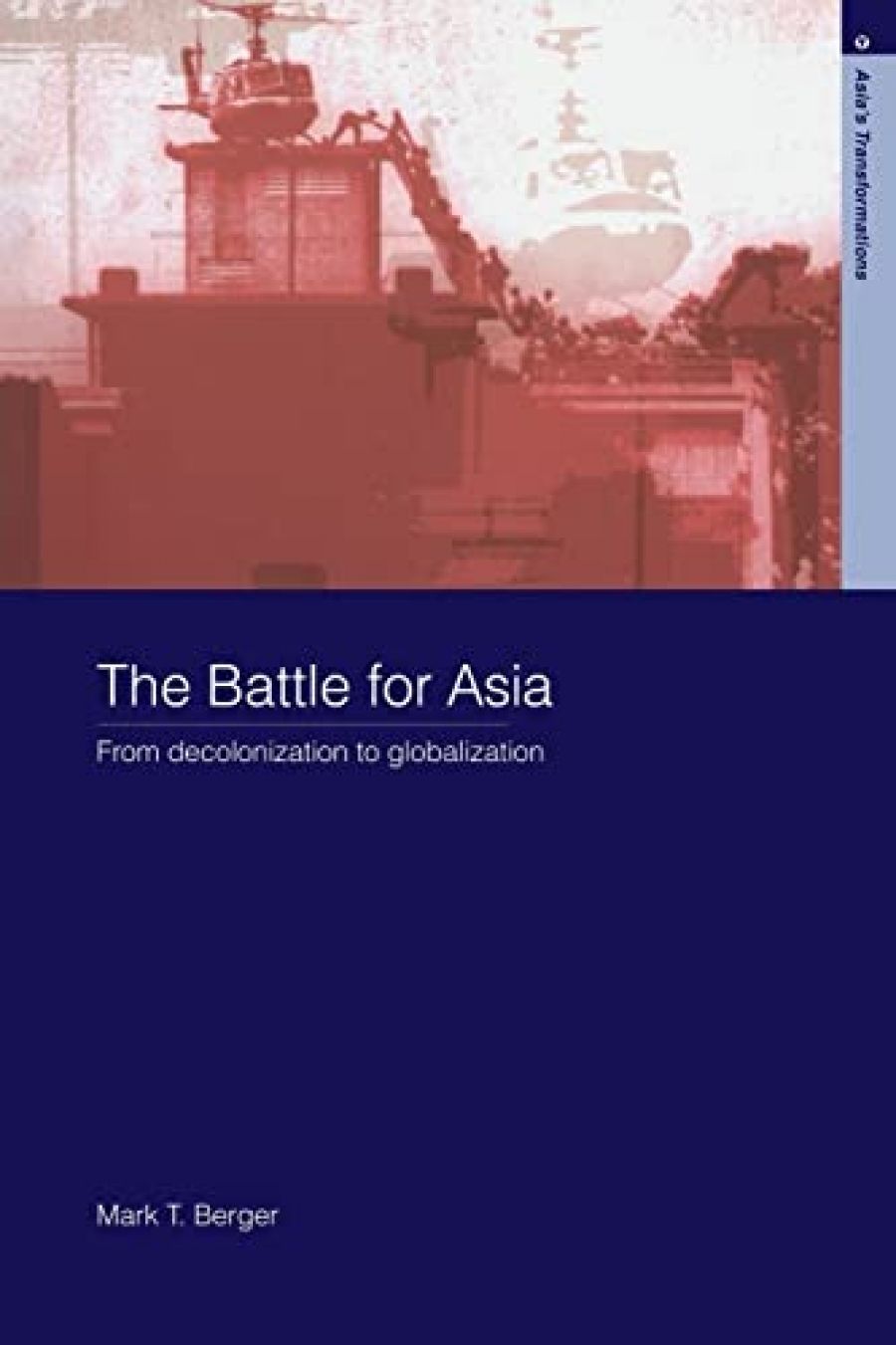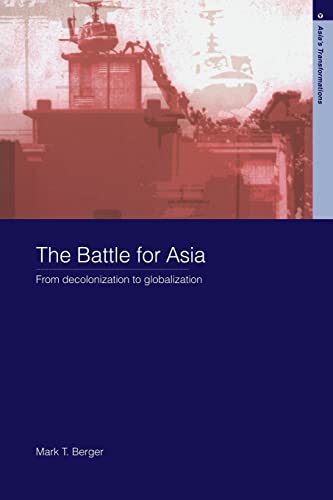
- Free Article: No
- Contents Category: History
- Custom Article Title: Pointing in the Right Direction
- Review Article: Yes
- Article Title: Pointing in the Right Direction
- Online Only: No
- Custom Highlight Text:
This book, The Battle for Asia, is the most recent and ambitious contribution from the group of Australian political economists, formerly based at Murdoch University, working on East Asian political economy. This book upholds the group’s Marxian structuralist orientation and advances its critique of ‘neo-liberal’ globalisation. The book’s ambition to integrate post-World War II international political economy, Asia’s development trajectories and US hegemony widens this group’s analytical lens and deepens its links with the anti-globalisation movement. For Mark T. Berger, ‘many of the organizations and individuals involved [in the movement] are asking the right questions and pointing in the right direction’.
Berger shares with this movement the belief that the US is the single hegemonic power driving the global economy. He presents capitalism as an inherently unequal system prone to crisis and monopolisation. Global corporations, leading states, mainstream intellectuals and international bureaucrats are its shapers and main beneficiaries. All others are its excluded subjects.
- Book 1 Title: The Battle for Asia
- Book 1 Subtitle: From decolonisation to globalisation
- Book 1 Biblio: Routledge Curzon, $69 pb, 343pp
- Book 1 Cover Small (400 x 600):

- Book 1 Cover (800 x 1200):

The first project, spurred by decolonisation and the Cold War, focused on national development and state intervention. As set out in Part One of the book, development economics and modernisation theory were its flawed intellectual supports, while the Marshall and Colombo Plans, and the Bretton Woods system, were its institutional ones. South–South cooperation (cooperation among developing nations to insulate themselves against the global economy or to change it), the 1973 oil crisis and the Vietnam War were key self-generated challenges; challenges that failed to over-throw the project but spurred its replacement.
Part Two contends that since the 1970s, due to altered geo-strategic and geo-economic interests and the national development project’s contradictions, the US has launched the globalisation project that redefines the state and accelerates capitalism’s destructive tendencies. Privatisation has replaced state intervention; open capital accounts have replaced limits on capital. Neoclassical economics is the project’s intellectual underpinning, while NAFTA, the WTO and the IMF are its institutional ones. The growing number of emerging market financial crises and failed states (and even September 11) are presented as its self-generated challenges.
For Berger, the national development project is over, while the globalisation project is being constructed. The first project universalised the nation-state system and helped win the Cold War by enhancing new states’ sovereignty. The globalisation project, energised by the end of the Cold War, is universalising capitalism and America’s enhanced hegemony by eroding sovereignty. States are forced to reorient themselves from national development to ‘market fundamentalism’.
Part Three, the only section that looks directly at Asia, is a series of short case studies of the regional battles over, and consolidation of, these sequential projects. Chapter Eight looks at the partial triumph of the US-led national development project over the communist challenge. Chapter Nine considers East Asian challenges to the globalisation project such as the Asian Values discourse, Japan’s attempts to universalise its development doctrine, and mainland China’s rise. Berger presents the post-World War II history of East Asia as US-defined and postulates that East Asian countries are now facing grave difficulties adjusting to the globalisation project.
The scope of Berger’s argument and its ideological commitments provide the book’s passion and its shortcomings. Berger does not provide a clear and detailed explanation of hegemonic projects or analyse the US political system or capitalism. While contending that the globalisation projects place new limits on sovereignty, he provides few examples. The book presents a broad-brush argument more than defending it.
Were the Asian financial crisis and the 2001 Argentinian crisis manifestations of oligopolistic capitalism, as claimed, and not simply due to these countries’ imprudent dependence on short-term capital and rigid monetary and fiscal policies? The openness of South-East Asian countries and their now flexible exchange-rate policies might better explain their rapid recovery and gird them against future volatility? Mainland China, since 1978, is one of the greatest beneficiaries of globalisation, not risking state failure due to it.
The bulk of the book is a critical literature review of mainstream US social science. It spends less time providing a historical understanding of Asian political economy. Asia’s challenge to the globalisation project covers less than thirty pages; the rise of mainland China is covered in four. The book’s narrative is weakened at times by anti-Americanism. On page 120, Berger posits that, prior to the first oil shock, the US encouraged the fledgling OPEC to raise prices to undercut Japanese and West German economic progress. However, he provides no evidence, despite this conjecture’s conspiracy theory tones.
Finally, the book underplays the influence of market forces in the incremental shift between Berger’s two projects. It presents Nixon’s ‘closing of the gold window’ as a purposive step by the US state to unleash global finance. However, Great Britain’s earlier moves to re-establish the City as the premier offshore banking centre and the huge amounts of private investment capital seeking escape from capital controls meant that by the 1970s the US had little choice but to float its ‘universalised’ currency. National development schemes challenge global market forces; globalisation accepts them.
The Battle for Asia is a bold contribution to the left’s critique of globalisation and is best treated as a critical literature review of mainstream US economics, international political economy and secondary source studies of East Asian development. Its criticisms of these schools of thought as state-centric and ahistorical are valid, timely and well worth examining. Along with this, the book’s impressive bibliography and scope make it particularly useful for advanced students of these fields. Its shortcomings mean that it is not a strong stand-alone book or a good introduction to East Asian political economy.


Comments powered by CComment